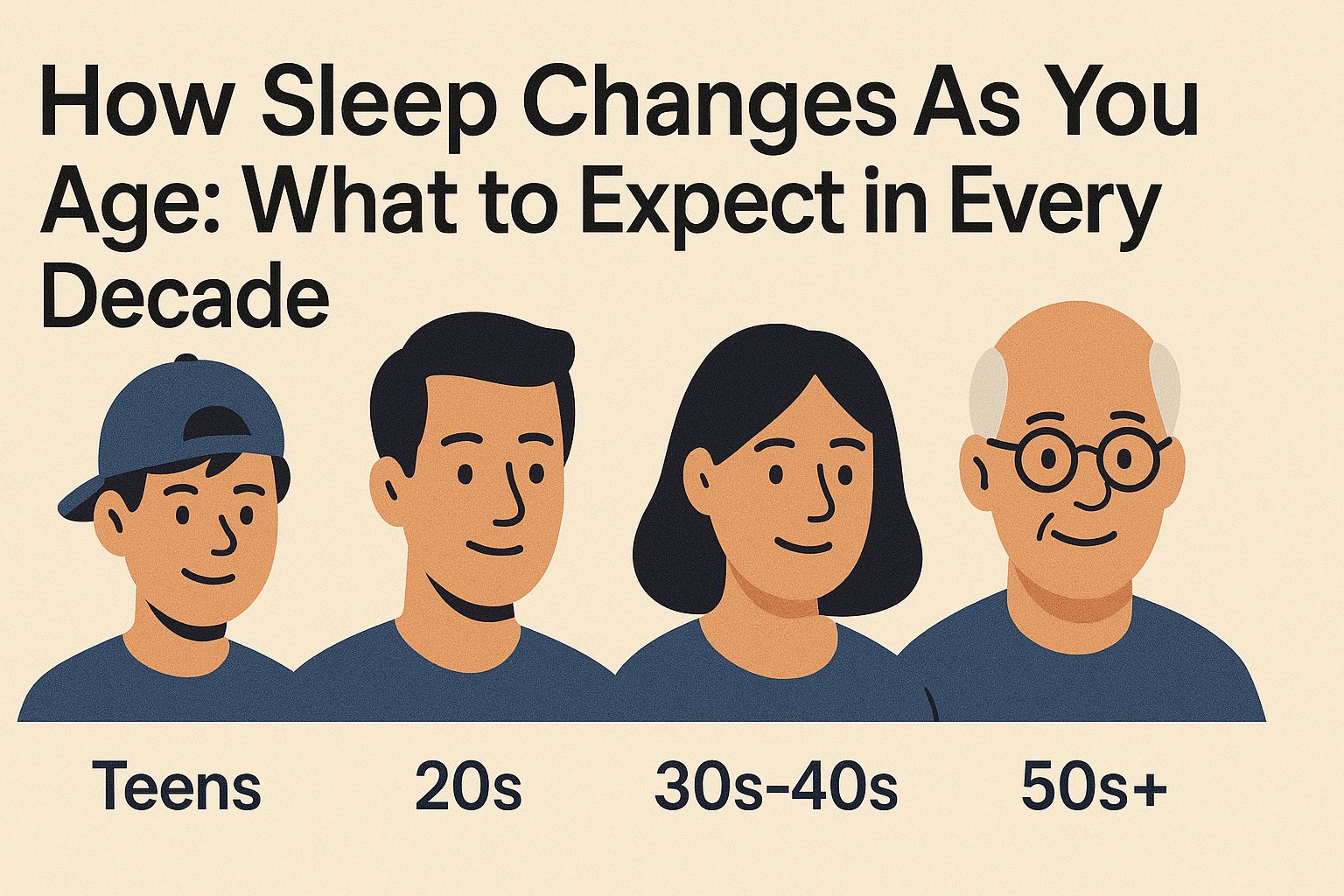How Sleep Changes As You Age: What to Expect in Every Decade

Sleep isn't static; it's a dynamic process that evolves throughout our lives. Just like our bodies and minds change with age, so do our sleep patterns, needs, and challenges. Understanding these natural shifts can help you navigate each decade with realistic expectations and proactive strategies for maintaining restorative rest.
Infancy & Childhood (0-12 Years): Building the Foundation
This stage is characterized by the highest sleep needs and rapid development of sleep architecture. Newborns sleep up to 17 hours a day in short bursts, gradually consolidating sleep into longer nighttime periods. REM sleep dominates early on, crucial for brain development.
Key Changes & Challenges:
- High Sleep Needs: 14-17 hours (infants), 10-13 hours (preschoolers), 9-11 hours (school-aged).
- Developing Circadian Rhythm: Gradually aligns with day/night cycles.
- Naps: Essential early on, gradually decreasing in frequency and duration.
- Challenges: Establishing routines, night wakings, bedtime resistance.
Adolescence (13-18 Years): The Great Shift
Puberty triggers a natural shift in the circadian rhythm, known as "sleep phase delay." Teenagers biologically feel tired later at night and need to wake up later in the morning. However, school schedules often conflict with this, leading to chronic sleep deprivation.
Key Changes & Challenges:
- Sleep Needs: Still high, around 8-10 hours per night.
- Circadian Shift: Melatonin release shifts later, making early bedtimes difficult.
- Social/Academic Pressures: Homework, activities, and social life often cut into sleep time.
- Technology Use: Increased screen time, especially before bed, further delays sleep.
- Challenges: Difficulty waking for school, daytime sleepiness, weekend "catch-up" sleep disrupting rhythm.
Young Adulthood (19-29 Years): Lifestyle Impacts
Sleep needs stabilize around 7-9 hours. However, this decade often involves significant lifestyle changes—higher education, starting careers, new relationships, potential parenthood—that can disrupt sleep schedules and increase stress.
Key Changes & Challenges:
- Sleep Needs: Generally 7-9 hours.
- Irregular Schedules: University life, shift work, socializing can lead to inconsistent sleep patterns.
- Stress: Career building, financial pressures, and relationship changes can cause anxiety affecting sleep.
- Challenges: "Social jetlag" (different weekday/weekend schedules), prioritizing sleep amidst competing demands.
Middle Adulthood (30-59 Years): Subtle Shifts & Rising Risks
Sleep needs remain around 7-9 hours, but subtle changes in sleep architecture begin. Time spent in deep sleep may start to decrease, and awakenings during the night might become slightly more frequent. Lifestyle factors like career stress, raising children, and early signs of health issues can impact sleep.
Key Changes & Challenges:
- Sleep Needs: 7-9 hours, though some may feel rested on slightly less.
- Decreased Deep Sleep: Gradual reduction in slow-wave sleep begins for many.
- Increased Sensitivity: More easily disturbed by noise, light, or discomfort.
- Health Conditions: Increased risk of conditions like sleep apnea, restless legs syndrome, pain, and hormonal changes (perimenopause) affecting sleep.
- Challenges: Balancing work/family demands, managing stress, addressing emerging health issues impacting sleep.
Older Adulthood (60+ Years): Adapting to Change
Significant changes in sleep patterns become more common. While the total sleep need remains around 7-8 hours, achieving it can be more challenging. Sleep becomes lighter, more fragmented, and the circadian rhythm may shift earlier (advanced sleep phase).
Key Changes & Challenges:
- Sleep Needs: 7-8 hours, but often achieved in fragmented periods.
- Lighter Sleep: Significant decrease in deep sleep, more time in lighter stages.
- Increased Awakenings: More frequent and longer awakenings during the night.
- Advanced Sleep Phase: Tendency to feel sleepy earlier in the evening and wake up earlier in the morning.
- Medical Conditions/Medications: Higher prevalence of health issues and medications that interfere with sleep.
- Challenges: Insomnia, daytime napping affecting nighttime sleep, managing sleep disturbances related to health conditions.
Strategies for Healthy Sleep Across the Lifespan
While sleep patterns change, the fundamentals of good sleep hygiene remain crucial at every age. Adapting strategies to meet the challenges of each life stage can help maintain quality rest:
- Consistency is Key: Maintain regular sleep and wake times as much as possible, even on weekends.
- Optimize Your Environment: Ensure your bedroom is dark, quiet, cool, and comfortable.
- Mind Your Light Exposure: Get bright light (preferably sunlight) in the morning and dim lights in the evening. Avoid blue light from screens before bed.
- Stay Active: Regular physical activity improves sleep quality, but avoid intense workouts close to bedtime.
- Watch Your Diet: Avoid heavy meals, caffeine, and alcohol close to bedtime.
- Manage Stress: Develop relaxing bedtime routines (reading, warm bath, meditation).
- Address Health Issues: Talk to your doctor about any health conditions or medications that might be affecting your sleep.
- Limit Naps (Especially Later in Life): If you nap, keep them short (20-30 minutes) and earlier in the day.
Listen to Your Body
While guidelines exist, individual sleep needs can vary. Pay attention to how you feel during the day. If you consistently feel tired, irritable, or have trouble concentrating, you may need more sleep or better quality sleep, regardless of your age. Don't hesitate to consult a healthcare professional if you have persistent sleep concerns.
Understanding the natural evolution of sleep as we age empowers us to adapt our habits and expectations. By implementing age-appropriate strategies and prioritizing sleep hygiene, we can strive for restful nights and energized days throughout our entire lives.



